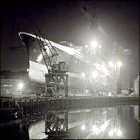Ship number 736
The keel of John Brown job number 736 was laid on 5 July 1965, the day after Cunard’s 125th anniversary, the actual anniversary falling on Sunday, a non-working day. The ship was to be a two-class liner that could be modified into a single-class cruise ship, allowing the ship to ply the Atlantic during the summer season, and then cruise in warmer waters during the winter.
The name of the ship was kept a secret and as the day of the launch approached, book-makers were offering odds on such names as Churchill, Prince Charles, New Britain and Queen Victoria with Queen Elizabeth at a lowly 14-1. At 2.28, two minutes early, Queen Elizabeth stepped forward and named the ship, Queen Elizabeth the Second, being the second ship called Queen Elizabeth, and pressed the button that sent all 963 feet (294 metres) of her onto the Clyde. Thousands of people on the riverbank cheered, while thousands more watched the event live on television. As Roman numerals are always used for monarchs, the Arabic numeral 2 is used in the ship's name to distinguish her from the monarch, and she has always been referred to as, Queen Elizabeth Two, or most often as the QE2.
Cunard wanted the ship to be modern and reflect 1960s Britain, as well as having the most modern advancements in maritime design. The QE2, like other ships of her day, has a bulbous bow, a protruding bulb at the front, below the waterline, to modify the water flow around the hull, reducing drag and increasing speed and fuel efficiency. Her funnel was an innovation; its design ensured that exhaust fumes were carried well away from the passenger decks in the rear. Since 1967 the ship has been fitted out and refitted several times, including the replacement of her oil-fired steam turbine power plant with diesel electric in 1986. This raised her top speed form 32.5 knots to 34 knots, one of the fastest passenger ships on the seas.


